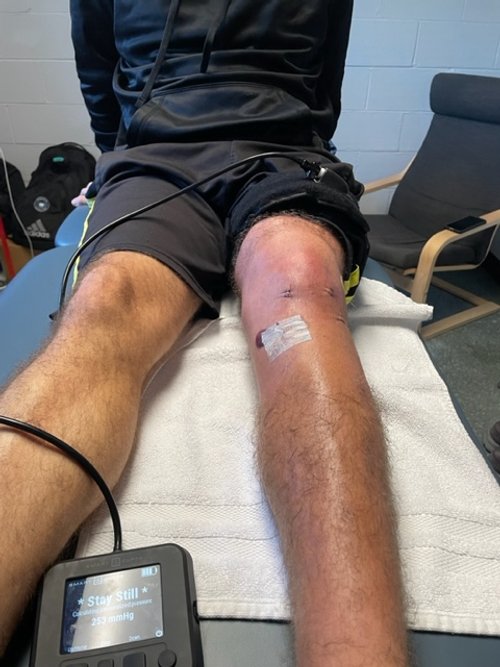How to Take Care of Yourself After a Surgery
Are you about to undergo an orthopedic surgery? Or maybe you’ve just had a surgery but you’re struggling with the pain management side of things? You’re not alone; operations can be scary. But I’m here to help guide you through the initial post-operative period.
Let’s break this down into a few different categories. All of them are important, some maybe more so than others, depending on your particular case.
Blood clots can be extremely problematic.
1. Blood clot prevention: Orthopedic surgeries are often painful procedures after which you may be less able to move through your available range of motion. You also may not be allowed to move a certain way or put weight through the impacted area for a period (see the “tissue integrity” section below). This increase in sedentary activity can become problematic when paired with post-surgical swelling. Your venous system has a harder time pumping blood back to the heart, so it winds up overwhelmed and your blood stream stagnates. This stagnation allows more time for blood clots (DVTs- deep vein thromboses) to form. These can be dangerous, especially if they travel up to the lungs and become pulmonary embolisms (PEs). Your doctor and/or PT may therefore encourage you to move as much as allowed and to stay hydrated post-operatively to prevent blood clots from forming. Your doctor may also recommend that you take a blood thinner (Aspirin, warfarin, coumadin, etc.) if you are higher risk. Follow your specific instructions!
2. Infection prevention: I can speak from personal experience here. Many years ago, I had a right foot surgery to fix a college soccer injury. I was frustrated that the candy cane-sized incision on the bottom of my foot hadn’t healed after two weeks. In my infinite wisdom (sarcasm), I washed it with a washcloth in the shower. Lo and behold, it got infected. I nearly needed a second surgery to clean out the original incision. Learn from my mistake! Infections wreak havoc on otherwise sound procedures. Keep the incision covered and clean, and avoid excessive moisture. If prescribed antibiotics after your surgery, take them fully based on the directions on the bottle. Follow your doctor’s orders, and please don’t wash it with a washcloth…
3. Tissue integrity: As an example, if you had your meniscus repaired in your knee, you are likely to be on non-weight bearing orders for at least a few weeks. This recommendation is often made because the meniscus is fragile and needs time to allow the surgical sutures to heal the recently-repaired tissue. Whatever the operation is, you need to provide the joint, muscle, ligament, tendon, etc. the optimal environment it needs to heal. That may be non-weight bearing, partial weight bearing with crutches, or maybe weight bearing as tolerated. It may even include a sling or cast. You must be patient during the initial few weeks while the healing tissue can recover. The only thing worse than tearing your ACL is tearing it a second time and having to start all over again.
4. Pain and swelling management: Surgery is trauma! The surgeon will carefully cut into your tissue and do whatever they need to do. Have you ever seen a YouTube video of a surgery??? The procedure will naturally produce a lot of swelling, and swelling causes pain. Although some post-operative swelling can be a good thing (it can help encourage blood flow and tissue healing factors to the area, reducing healing time), too much is problematic. Manage your pain with prescribed medications, anti-inflammatories (as allowed), ice, elevation, and compression wraps. As the swelling dissipates, so too will your pain. Remember that, while often helpful in the short-term, opioid pain medications have significant side effects and are not necessarily something you want to take in the long-term, unless you and your physician decide otherwise.
5. Sleep: We spoke earlier about tissue integrity, aka giving the repairing tissue an adequate environment to successfully heal. Part of this environment includes taking care of your body with a strong diet, water consumption, and sleep! The goal is to resume sleeping eight hours per night as soon as possible. Given your pain and swelling may initially prohibit this, get your sleep any way you can. This may initially be in 60-minute increments multiple times per day, but it will gradually get easier as pain goes down. Make sure you check with your surgeon on your recommended sleeping position. After my foot surgery, I was required to sleep on my back for four weeks, which is my personal least favorite. We should not be subject to chronic poor sleep!
BFR (blood flow restriction) being used on the left leg of a patient after a recent left knee surgery.
6. Atrophy management: Last but not least, atrophy: the expected loss of muscle mass after surgery. Pain and swelling inhibit your ability to move freely and you’re likely not cleared to bear full weight on the operated limb anyway. Ever heard of “use it or lose it”? If you ignore the muscle long enough or don’t stress it enough, it loses size and strength which can lead to future issues. While some level of atrophy is expected after a surgery we have ways of mitigating this in PT, including with blood flow restriction training! Read our blog post about this incredibly effective technology - available to all clientele of Premier Physical Therapy. If we can slow down your atrophy, your recovery will be easier and you’ll get back to your regular activity more quickly.
Surgery can be scary. Let us show you the way back to your optimal quality of life. Give us a call today: 980-766-9740.


